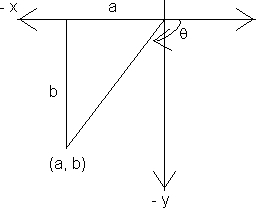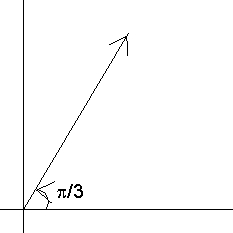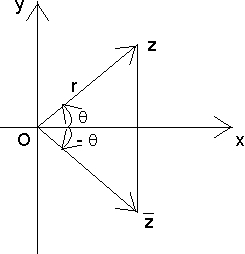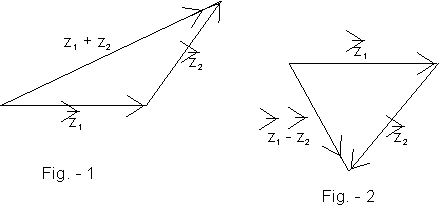Complex Numbers - 2
(2) Second Question : a < 0 , b < 0 then the principal value is arg (z)=  is an obtuse angle & positive.
is an obtuse angle & positive.

(3) a < 0, b < 0 then the principal value is argz = 
 is an obtuse angle & negative
is an obtuse angle & negative
(4) fourth Question : a > 0, b < 0 then the principal value is arg (z) is an acute angle & negative
Dumb Question:- Find the modulus & amplitude of 
(a) - 4, 3i (b) 4, 3i (c) + 4, 0 (d) 4e-3, 
Ans: At first sight it looks like
At first sight it looks like  , but modulus can’t be negative & also
, but modulus can’t be negative & also  can’t be imaginary so to make modulus positive we write
can’t be imaginary so to make modulus positive we write

Now comparing with  we get
we get 
ILLVATRATION - 2. What does arg (z) = 

arg(z) =  shoues that Z is in first Quadrant & join of Zwith origin makes an angle of
shoues that Z is in first Quadrant & join of Zwith origin makes an angle of  with positive direction of x axis. Hence of Z is an open ray as shown in figure
with positive direction of x axis. Hence of Z is an open ray as shown in figure
CONJUGHTE OF A COMPLEX NUMBER
The complex number of z=a+ib &  are called complex conjugate of each other. The complex conjugate is obtained by changing the sign of imaginary part.
are called complex conjugate of each other. The complex conjugate is obtained by changing the sign of imaginary part.

In polar from complex conjvgates are having same modulus & modulus of angle is same but the Angles differ in sing,
PROPERTIES OF CONJUGATE
(1) 
Why ? 
(ii)  z is purely real (both sided equality)
z is purely real (both sided equality)
Why ?

 ie purely real
ie purely real
(iii)  is purely imaginary
is purely imaginary
Why ? if z = ki
then  = - ki Hence z = -
= - ki Hence z = -
(iv)
Why ? Let z1 - a1 + ib2
then 
& 
 clearly (1) = (2)
clearly (1) = (2)
(v) 
(vi) 
Why ? Let 

(vii) 
(viii) 
Why ? Let

PROPERTIES OF MODULUS
(i)  & if (iff) z = 0
& if (iff) z = 0
Why? |2| = r = distance of any point from orgin & distance can’t be negative.
(ii) 
Why ? Re(z) = r cos Im(z) = r sin
Im(z) = r sin
So,  which is true.
which is true.
(iii)  (most important & frequently used property)
(most important & frequently used property)
Why ? 
(iv) 

(v) 
(vi) 
(viii) 
When point z is joined kto origin O then the vector  can be used to represent complex
can be used to represent complex
number z. We know that in a triangle sum of two sides is always greater thann third side. By using this concept the above property will be proved.

In figure 1:

Dumb Question:- What happens when 
Ans:- By same way we can also prove that

combining both (1) & (2)we can write

In figure2:


BY (3) & (4)

(viii) 
Why ? Look at figure 1 of last property
we can writ 
because sum of two sides of triangle is greater than third side.
Modulus is always +ve. hence we can write.

Then 
& 
Hence 
Dumb Question:- How can you kget eqn(7)from eqn(5)& 6 ?
Ans: suppose 

Hence 10 > 4 & nalso 10 > -4
If 10 > 4 it is obviously reater than - 4 but when we can use eqn. (7) to make sure that we compare + ve quantitics.
(ix) 
Why? Let 
then L.H.S. 

R.H.S. 
Dumb Question: Why  ?
?
Ans:- We know that 

why ? By one of the previous properties
 using this
using this


Dumb Question: Why 
we know that 
here 
PROPERTIES OF ARGUMENT
(i) Arg 
Why ? Let 
then L.H.S> 

R.H.S. 
s (ii) Arg 
(iii) Arg 
Let 